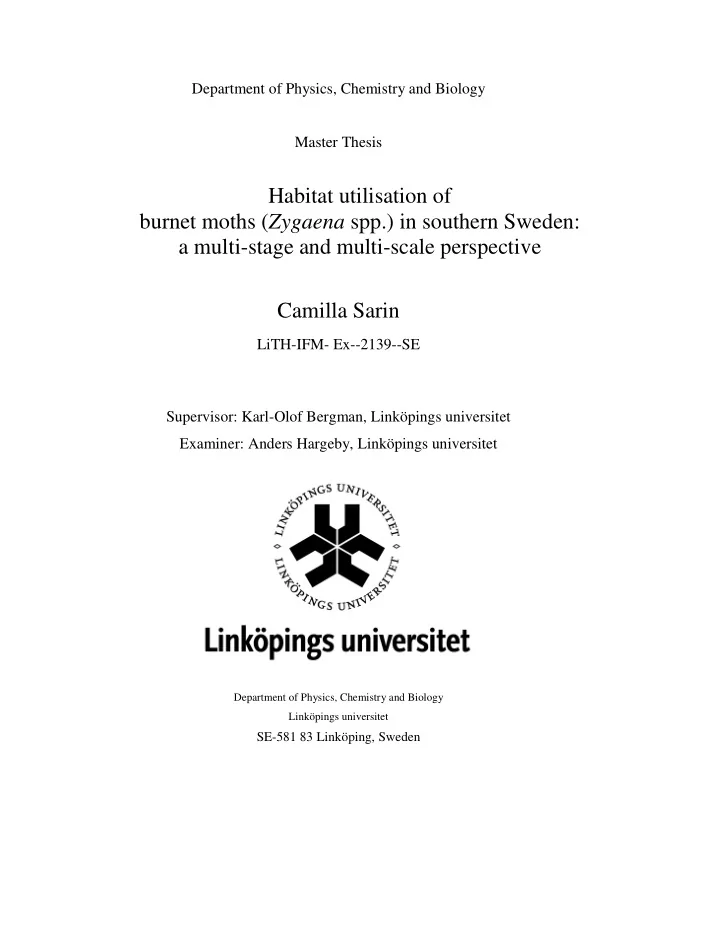

Department of Physics, Chemistry and Biology Master Thesis Habitat utilisation of burnet moths ( Zygaena spp.) in southern Sweden: a multi-stage and multi-scale perspective Camilla Sarin LiTH-IFM- Ex--2139--SE Supervisor: Karl-Olof Bergman, Linköpings universitet Examiner: Anders Hargeby, Linköpings universitet Department of Physics, Chemistry and Biology Linköpings universitet SE-581 83 Linköping, Sweden
Avdelning, Institution Datum Division, Department Date Avdelningen för biologi 2009-05-19 Instutitionen för fysik och mätteknik Språk Rapporttyp ISBN Language Report category LITH-IFM- A-EX--—09 /2139—SE Svenska/Swedish Licentiatavhandling __________________________________________________ x Engelska/English x Examensarbete ISRN C-uppsats __________________________________________________ x D-uppsats ________________ Övrig rapport Serietitel och serienummer ISSN Title of series, numbering _______________ Handledare URL för elektronisk version Supervisor: Karl-Olof Bergman Ort Location: Linköping Titel Title: Habitat utilisation of burnet moths ( Zygaena spp.) in southern Sweden: a multi-stage and multi- scale perspective Författare Author: Camilla Sarin Sammanfattning Abstract: Three species of burnet moths ( Zygaena filipendulae , Z . lonicerae and Z . viciae ) were studied on the Baltic island Öland, Sweden, in order to reveal the habitat requirements of different life stages. Larvae were found among a higher cover of their most important host plant, Lotus corniculatus , Trifolium medium / pratense or Vicia spp., than were pupae or imagines, and were also observed on plants larger than randomly examined plants. Imagines actively selected nectar plants of Centaurea and Cirsium , growing in sunny conditions, but other red and violet Asteraceae flowers were also favoured. Pupae of Z . filipendulae appeared in taller vegetation than larvae and imagines, probably because the cocoons are spun high on stems of grasses and other plants. The chance of finding such suitable substrates rises with increasing vegetation height. A large scale analysis of occupancy patterns was also made, evaluating the relationship between burnet presence or absence and the area of meadows and pastures within 10 x 10 km grid cells in southern Sweden. All three species showed a positive relationship with increasing area of semi-natural grassland. Thresholds for the amount of habitat, below which the likelihood of occurrence declined more rapidly, could be distinguished around a 40-50 % probability of occurrence. Conservational work should aim at preserving and restoring open and sunny areas rich in the respective host plants and nectar sources, but vegetation management must be executed with great care or late in the season to not harm unhatched pupae and to maintain substrates suitable for Z . filipendulae pupation. Nyckelord Keyword: Conservation, habitat cover, habitat requirements, life stages, occurrence probability, Zygaena
Contents 1 Abstract.............................................................................................................1 2 Introduction.......................................................................................................1 3 Materials and methods.......................................................................................2 3.1 Study species..............................................................................................2 3.2 Study sites ..................................................................................................3 3.3 Species surveys and habitat characteristics..................................................3 3.3.1 Larvae..................................................................................................3 3.3.2 Pupae...................................................................................................4 3.3.3 Imagines ..............................................................................................4 3.4 Inventory criteria ........................................................................................5 3.5 Controls......................................................................................................5 3.6 Large scale studies......................................................................................6 3.7 Statistical analyses......................................................................................6 4 Results ..............................................................................................................6 4.1 Larval host plants........................................................................................7 4.2 Cover of larval host plant............................................................................7 4.2.1 Larva ...................................................................................................7 4.2.2 Pupa.....................................................................................................7 4.2.3 Imago...................................................................................................8 4.2.4 Between stages.....................................................................................8 4.3 Larval host plant area..................................................................................8 4.4 Vegetation height........................................................................................9 4.4.1 Larva ...................................................................................................9 4.4.2 Pupa.....................................................................................................9 4.4.3 Imago...................................................................................................9 4.4.4 Between stages...................................................................................10 4.5 Cover of bare ground ................................................................................10 4.5.1 Larva .................................................................................................10 4.5.2 Pupa...................................................................................................11 4.5.3 Between stages...................................................................................11 4.6 Cover of dry grass.....................................................................................11 4.6.1 Larva .................................................................................................11 4.6.2 Pupa...................................................................................................11 4.6.3 Between stages...................................................................................11 4.7 Sun exposure ............................................................................................12 4.7.1 Larva .................................................................................................12 4.7.2 Pupa...................................................................................................12 4.7.3 Imago.................................................................................................12 4.7.4 Between stages...................................................................................13 4.8 Nectar plants.............................................................................................13 4.9 Large scale studies....................................................................................14 5 Discussion.......................................................................................................17 5.1 Host plants, nectar sources and sun exposure ............................................18 5.2 Surrounding vegetation.............................................................................19 5.3 Large scale ...............................................................................................19 5.4 Implications for conservation....................................................................20 6 Acknowledgements .........................................................................................21 7 References (Insect Conservation and Diversity format)....................................21
Recommend
More recommend